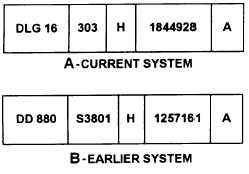where the number 80064 identifies NAVSHIPS. In view
B, the number 80091 identifies the Naval Facilities
Engineering Command.
3. The first part of the system command number is
a three-digit group number. It is assigned from the
Consolidated Index of Drawings, Materials, and
Services Related to Construction and Conversion,
NAVSHIPS 0902-002-2000. This number identifies the
equipment or system, and sometimes the type of plan.
In figure 1-1, view A, the number 800 under the
NAVSHIP SYSTEM COMMAND NO. block
identifies the plan as a contract plan.
4. The second part of the system command number
is the serial or file number assigned by the supervisor
of shipbuilding. Figure 1-1, view A, shows the number
2647537 as an example under the NAVSHIP SYSTEM
COMMAND NO. block.
5. The revision letter was explained earlier in the
chapter. It is shown under the REV block as A in figure
1-1, view A.
Figure 1-8, view B, shows the shipboard plan
numbering system that was in use before the adoption
of the current system (view A). They two systems are
similar with the major differences in the group numbers
in the second block. We will explain the purpose of each
block in the following paragraphs so you can compare
the numbers with those used in the current system.
The first block contains the ship identification
number. The examples in views A and B are DLG 16
and DD 880. Both refer to the lowest numbered ship
to which the plan applies.
The second block contains the group number. In
view A, it is a three-digit number 303 taken from
NAVSHIPS 0902-002-2000 and it identifies a lighting
system plan. View B shows the group number system
Figure 1-8.—Shipboard plan numbers.
in use before adoption of the three-digit system. That
system used S group numbers that identify the
equipment or system concerned. The example number
S3801 identifies a ventilating system. To use this
number, relate it to the proper chapter of an NSTM.
Replace the S with the 9 of an NSTM chapter number
and drop the last digit in the number. For example, the
number S3801 would produce the number 9380, or
chapter 9380 of the NSTM titled “Ventilation and
Heating.”
Blocks 3, 4, and 5 use the same information in the
old and new systems. Block 3 shows the size of the
plan, block 4 shows the system or file number, and
block 5 shows the version of the plan.
FILING AND HANDLING BLUEPRINTS
On most ships, engineering logroom personnel
file and maintain plans. Tenders and repair ships may
keep plan files in the technical library or the microfilm
library. They are filed in cabinets in numerical
sequence according to the three-digit or S group
number and the file number. When a plan is revised,
the old one is removed and destroyed. The current plan
is filed in its place.
The method of folding prints depends upon the
type and size of the filing cabinet and the location of
the identifying marks on the prints. It is best to place
identifying marks at the top of prints when you file
them vertically (upright), and at the bottom right
corner when you file them flat. In some cases
construction prints are stored in rolls.
Blueprints are valuable permanent records. How-
ever, if you expect to keep them as permanent records,
you must handle them with care. Here are a few simple
rules that will help.
Keep them out of strong sunlight; they fade.
Don’t allow them to become wet or smudged
with oil or grease. Those substances seldom dry out
completely and the prints can become unreadable.
Don’t make pencil or crayon notations on a print
without proper authority. If you are instructed to mark
a print, use a proper colored pencil and make the
markings a permanent part of the print. Yellow is a good
color to use on a print with a blue background
(blueprint).
Keep prints stowed in their proper place. You
may receive some that are not properly folded and you
must refold them correctly.
1-10

